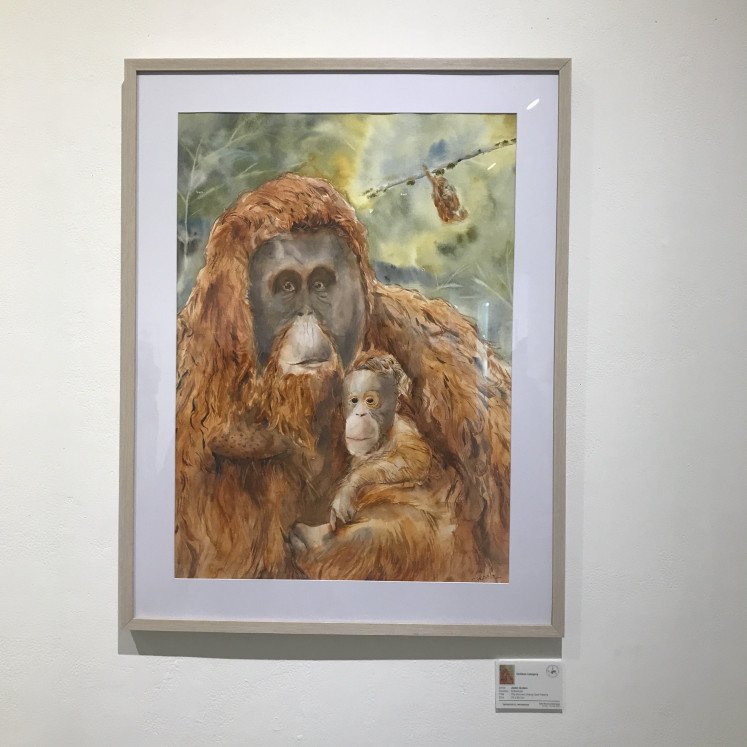December 19, 2022
JAKARTA – A watercolor painting exhibition at the National Gallery of Indonesia, Central Jakarta, shows the viability of this old-school medium in an art scene dominated by NFT images, digital media and video collages.
The space at the National Gallery of Indonesia’s B building overwhelmed those who entered the space. The effect is akin to soaring, as the simulated clouds up in the sky gave way to expanses of watercolor-blue seas and verdant specks of land. Titled Floating, the installation simulated flights over Indonesia, which was the effect that its creator, Agus Budianto, perhaps had in mind.
“Do not even think about damaging your homeland, much less owning it,” warned the self-taught painter in Melayang (Flying), a verse for the work that the self-taught artist perhaps meant as an ode to Indonesia. “In fact, you are part [of the Indonesian archipelago] […] from the day you were born until the day you die. So be proud to be [an] Indonesian, and may Indonesia be great again!”
Agus’ proclamation is backed by Floating’s 600 centimeter by 800 cm scale, and the sheer number of items he used to make the installation. They included “40 tubes of Daniel Smith watercolor paint, eight rolls of Hahnemuhle paper, 35 De Goya aerosol varnish […] seven aerosol glue bottles, [instrument] strings and 10 rolls of masking tape”.
Agus’ use of a whole room instead of a canvas frame also blurred the lines between art and the viewer, as the latter can enter Melayang for a walk among the clouds, seas and land.

Fuzzy sort of love: Jaden Anders captures the warmth and love of an orangutan mother and child through “Orang Utan Family”. (JP/Tunggul Wirajuda) (JP/Tunggul Wirajuda)
Maintaining watercolors
Melayang is one of the 141 watercolor artworks featured in the 4th International Watercolor Society (IWS) Exhibition at Jakarta’s National Gallery. Themed Wonderful Indonesia, the event presents the work of 176 artists from 31 countries.
IWS Indonesia country leader Umi Haksami said the theme was chosen “to commemorate and celebrate” the 77th anniversary of Indonesia’s independence. This year, [the exhibition has] incorporated [a] children’s category for the first time” since the IWS exhibition’s inception in 2015.
IWS Globe Art Network founder and president Attanur Dogan agreed, noting that the children’s category will help “share our passion for watercolors with the upcoming generations”.
Indonesian painter Jaden Anders reflected this premise in his work, Borneo Orang Utan Family. The child artist captured the warmth and love between the female and its young through their tender gaze and their fuzzy red fur. Fellow artists Priscilla’s Burung Enggang (Hornbill) and Evolet Faith Samayim’s I Am Willing to Be Alone similarly highlighted Indonesia’s diverse fauna.
Portraying a hornbill and tiger, respectively, the three paintings perhaps conveyed the species’ determination to survive in the face of manmade odds like deforestation and poaching. Canadian artist Luan Quach took on similar themes with Mastery. The work, which juxtaposed a Komodo dragon next to a human, viewed the reduction or changes to habitat as a power struggle between humans and wildlife.
Danni Liu’s work Abundant Blessing deftly used traditional culture to convey a similar element of timelessness and mystique as her younger counterparts’ rendition of Indonesia’s fauna.
“[Abundant Blessing used] excellent lighting […] [to create] a dramatic atmosphere of the silence one contains, sublime, through the drawing of a child praying,” noted exhibition curator Efix Mulyadi of the Australian’s watercolor, which won first prize in the figurative category from the multinational panel of eight juries.
The portrait of the child praying at a Hindu temple in Bali seemed to allude to her devotion, while the halo of light surrounding the girl perhaps portrayed the enduring, timeless nature of faith.

Feeling grateful: Danni Liu captures a Balinese girl carrying out a traditional ritual at a temple in “Abundant Blessing”. (JP/Tunggul Wirajuda) (JP/Tunggul Wirajuda)
Tradition and culture imagery
At a glance, the portrayal of cultural motifs might be a feature in line with the exhibition theme, Wonderful Indonesia. But Efix asserted, “Decorative [works] playing with motifs continues to be one of the most effective ways to display the [artists’] Indonesian-ness,” along with “hunting for objects that are uniquely local but global, such as temples, reliefs, statues as well as archeological buildings”.
These include Audrey Katherine’s Colors of Our Heritage, Rosa Yasmine’s Tranquility in the Water Palace and Hendriko Teguh S.’ Passing By. While one might think they are in line with the exhibition theme, the ethereal rendering of these watercolors is still striking, as they seem to capture fleeting details that are gone with the blink of an eye.
Likewise, Dionisia Devona’s Ulos, the Eternal Warmth and Deskamtoro’s Gossip with Friends sought meaning and humanity through traditions. Known as the age-old tenun or woven cloth of the Batak people of North Sumatra province, the traditions evoked by the former’s folds seemed to provide comfort for their wearer, particularly if they are family heirlooms passed on for generations.
On the other hand, Gossip with Friends showed the bonds that customs and traditions, in this instance traditional dances, can be formed for generations of practitioners. Most of all, the watercolors proved 19th-century French writer Jean-Baptiste Alphonse Karr’s premise that “the more things change, the more they stay the same”.
4th IWS Indonesia International Competition & Exhibition 2022: Wonderful Indonesia
To Dec. 20
National Gallery of Indonesia
Jl. Medan Merdeka Timur no. 14, Gambir, Central Jakarta 10110
Opening hours Tuesday 9:00 a.m.-4:00 p.m. (permanent collection), 10:00 a.m.-7:00 p.m. (temporary exhibition)
Website: gni.kemdikbud.go.id
Instagram: @galerinasional
Facebook: facebook.com/galnas/
Twitter: @galerinasional_


